Introduction
Currently, coffee has been one of the most notable commercially traded products in the world market since it has become the most popular beverageworldwide.1 The various tastes of the coffee beverage are typically influenced by some factors including a plant variety or cultivar, the areas of cultivation, cultivation methods, quality of the plant seeds, method of processing, mixture, and roasting processes.2,3 One of the essential processing methods in coffee production is the fermentation process. The key purpose of the fermentation process of coffee production is to remove the pulp and mucilage layer, reduce water content, and also to improve the quality of the coffee beans.4
Coffee cherry is unprocessed coffee that still has pulp and mucilage surrounding its beans. The coffee pulp typically contained crude carbohydrates, proteins, free amino acids, fatty acids, and minerals5,6while mucilage contained .7During the fermentation of coffee microbial consortia involved would convert pulp and mucilage to produce metabolites that would affect the flavors and aroma of the coffee.8Some studies revealed that the process of fermentation in coffee would enhance the variety of the compounds of coffee aroma and flavors.9,10The activities of microorganisms and the extent of fermentation would stipulate the free sugar concentration and free amino acids, which proceed to cover the bean and then assist to generate Maillard compounds and volatile during the process of roasting.11
The current practice in coffee fermentation conducted amongst coffee producers is natural fermentation. This process highly depends on the indigenous microbiota related to the coffee farm microbiome.12This method would generate some variations and thereby require further study to evaluate its effect on the quality of coffee.13 Currently, the starter cultures introduced to the fermentation of coffee have been claimed to succeed in conventional natural processes. This method is significant since it would make the fermentation of coffee more consistent, predictable, and restrained.14 The limitation of the method is that the fermentation process is conducted in open chambers, which are susceptible to the contamination of the natural microbiota.12
Many studies have been carried out on the fermentation of coffee beans using specific microorganisms, such as yeast and lactic acid bacteria.15,16The use of pure culture to perform fermentation of coffee would tend to generate specific metabolites(i.e. ethanol and lactic acid). This would be different if the fermentation was carried out using mixed microbial culture, which could generate various fermentation end-products.7,17This would significantly affect the physicochemical properties of the coffee bean and potentially enrich its flavors and aroma. The purpose of the current research is to study the effects of mixed-microbial culture from civet fecal suspensions as the mixed culture starters used for the fermentation of Arabica coffee. The type of Arabica coffee used for the experiment was the unpeeled coffee or the Arabica coffee cherries. Different proportion of inoculum introduced was investigated to evaluate the suitable concentration of inoculum that would be applied to the fermentation of Arabica coffee cherries.
Materials and Methods
Coffee Bean Collection
The type of coffee used in this study was coffee cherries of Arabica coffee (Coffea arabica) beans. They were obtained from the coffee plantation situated in the Jeget Ayu Village, Jagong Jeget Subdistrict, Central Aceh Regency, Aceh Province, Indonesia. After collection, the coffee cherries were immediately sorted as well as cleaned to remove some undesired materials, such as leaves, stalks, sand, and gravel that could hinder the processes of fermentation. To evaluate the effectiveness of fermentation processes inoculated by the digestive civet microbes, the different proportion of inoculum was introduced to the coffee beans including 5, 10, 20, and 40% of inoculums. The control was set up in which the coffee bean was naturally fermented without adding any inoculum of civet fecal suspension.
Inoculum Preparation
The coffee beans were fermented by using civet feces suspension, which was selectively enriched from the mixed microbial cultures of civet feces. The civet feces covering coffee beans were obtained and/or collected from the coffee plantation in the Jagong Jeget Sub district, the District of Central Aceh. Before using the civet feces they were warmed at 37 ± 0.5°C to reactivate the microorganisms.
For the selective enrichment processes, 100 g of civet feces were mixed with culture media consisting of 100 ml of DI water, 1 g ofNaHCO3(Merck, Germany), 1 g of Bacto Peptone (Merck, Germany), and 1 g of Glucose Anhydrous (Merck, Germany) as a substrate. The cultivation process was carried out at a fed-batch mode reactor at 37 ± 0.5°C.The reactor was daily topped up with 100 ml of culture media containing substrate until it reached the volume of 1 liter. The physical characteristics of civet fecal suspension used as inoculum for the fermentation of Arabica coffee beans were presented in Table 1.
Table 1: Physicochemical properties of civet fecal suspension used as inoculum
| Parameters | Unit | Civet fecal suspension |
| pH | – | 7.01 |
| Electrical Conductivity | µS/cm | 21.8 |
| Total Dissolved Solids | mg/L | 10.9 |
| Optical Density | OD600 | 0.3 |
Experimental Design and Procedures
The inoculum used for the vitro fermentation of coffee beans was taken from the selective enrichment processes. The proportion of inoculums and the coffee beans were labeled as treatments from 1 to 4. Treatment 1 (T1) consisted of 10 ml of inoculums and 190 g of coffee beans. Treatment 2 (T2) contained 20 ml of inoculums and 180 g of coffee beans. Treatment 3 (T3) consisted of 40 ml of inoculums and 160 g of coffee beans. Treatment 4 (T4) contained 80 ml of inoculums and 120 g of coffee beans. Treatment 0 was a control containing 200 g of coffee beans without adding inoculums. To assure the vitro fermentation performing effectively, the operational temperature was set up close to the body temperature of the civet, which was about 37 ± 0.5°C.18The fermentation of the coffee beans was carried out in a series of batch reactors with the working volume of 200 ml. To ensure the fermentation process of coffee beans performing completely, the process was carried out for 48 hours.
Analytical Methods
pH, Total Dissolved Solids (TDS), and Electrical Conductivity (EC) Determination
To evaluate the effectiveness of -vitro fermentation of the coffee beans, each sample was regularly taken and analyzed including samples before and after fermentation. To monitor fermentation parameters including pH, and total dissolved solids (TDS) of the culture during the cultivation and fermentation processes, samples were measured by using a portable pH meter Model: MW 102 (Milwaukee, USA). Prior to the start of the analysis, pH meter was calibrated with some buffer solutions including 4, 7, and 10.19,20,21
Microbial Growth Determination
To assess the microbial growth during the cultivation processes of the mixed microbial cultures of civet feces, samples were analyzed usingUV-VIS Spectrophotometer Lab Equipment 325-1000nm 4nm 722N Ultraviolet (Yuchengtech, China). The wavelength applied for the optical density (OD) analysis of microbial growth was 600 nm. DI water was used as a blank in a spectrophotometer prior to the start of the OD analysis.
Analysis of Solid, Moisture, and Ash Contents
Analysis of solid and moisture contents was conducted by using a laboratory oven (Thermolyne Drying Oven, USA) at 105°Cfor about 24 hours. To determine the ash content, samples obtained from the solid analysis were subsequently put in the laboratory furnace (Thermolyne Muffle furnace, USA) under 500°C for about 30 minutes. All procedures of the analysis were performed according to the Standard Methods.19,22,23
Acid Content Determination
Titratable acidity (TTA) was analyzed to assess the total amount of acids generated during the fermentation of coffee beans. The titratable acidity was measured by using a Lab Standard pH meter (Milwaukee, USA). The titrant filled in the burette tube was 100 mM of NaOH (Merck, Germany). Before titration was started, some drops of 100 m Mphenolphthalein (Merck, Germany) were added to the analyte. To ensure reproducible data, all measurements were repeated.
Soluble Carbohydrate Determination
The soluble carbohydrate content of the coffee beans was measured by using the Glucometer, Bio Sensor AGM-2100 (Gluco Dr.auto, South Korea) with an assay method of electrochemical method (Gold electrode).To determine glucose concentration, the glucometer was in fitting to the test strips (Gluco Dr Biosensor Test Strips, South Korea). The determination of sugar concentration was performed at room temperature. To prevent an overlooked assessment of sugar concentration, each sample was diluted ten times. All procedures applied for the determination of sugar content infermented products were conducted according to the study byDarwin.24
Caffeine Determination
The determination of caffeine in the coffee beans was conducted by using a Laboratory Ultraviolet-Visible Spectrophotometer(Yuchengtech, China).150 ml of hot DI water was used to dissolve 1 g of the milled coffee. The mixture was filtered using 150 mm filter paper (Cat No 1001 150, Whatman, China)and placed into the flask. The coffee solution was mixed with 1.5 g of CaCO3(Merck, Germany), and subsequently extracted 4 times by using 25 mL of chloroform (Merck, Germany). The bottom layer of the mixture was separated and heated to remove the chloroform residue. For the caffeine analysis, the extract was diluted with DI water. The measurement of caffeine was conducted at the wavelength of 275 nm.25,26
Statistical
Experimental data collected during fermentation processes were statistically analysis with single factorial of analysis of variance (ANOVA). The data sample taken was conducted in triplicate. Besides, the data analyzed using ANOVA were tested with 5% (α = 0.05) level of significance to assess the influence of inoculums concentration towards the physicochemical characteristics of fermented Arabica coffee beans.
Results and Discussion
The results of the current study showed that pH in the cultivated culture gradually decreased from 7.5 to 6.2 at the early stage of the cultivation process (from day 1 to day 3). The growth of microbes represented in the OD value started to increase on day 2 of the process(Figure1). The OD value of the culture increased from 0.076 to 0.299 and reached its maximum value of 0.3 on day 9 of the cultivation process. Besides, at the end of the process pH of the culture was around 6.5 suggesting that the mixed microbial culture used for the coffee fermentation was ready for the acid stage processes.27,28
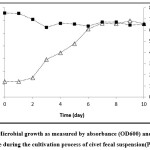 |
Figure 1: Microbial growth as measured by absorbance (OD600) and pH of the culture during the cultivation process of civet fecal suspension(P<0.05) |
The physicochemical properties of Arabica coffee cherries utilized in -vitro fermentation of civet are depicted in Table 2. Results revealed that the pH of the coffee cherries was quite low at around 5.30 indicating that the fermentation process would be performed under acidic conditions.29 As depicted in Table 2, some parameters of the coffee cherries including total solid (52%) ash content (8%)and caffeine (2.20%) indicated that they contained potential substrates that could be used for the microbes as their source of energy and minerals to perform the fermentation processes.23,30 The sugar content of the coffee cherries was about 17 mM which would also be used as a source of carbon for the microbes and may be converted to alcohols, organic acids, and other metabolites that could enhance the quality of the fermented coffee beans.
Table 2: Physicochemical properties of Arabica coffee cherries before fermentation
| Parameters | Unit | Arabica Coffee Bean |
| Moisture content | % | 48.40 ± 0. |
| Ash content | % | 7.95 ± 0.01 |
| Total Solid | % | 51.60 ± 0.03 |
| Glucose | mmol/L | 17.00 ± 0.02 |
| Alkalinity | mmol/L | 3.13 ± 0.01 |
| Caffeine | % | 2.20 ± 0.02 |
| pH | 5.30 ± 0.03 |
(P<0.05)
The results showed that all fermented coffee cherries had low pH between 4.0 and 5.2 indicating that the fermentation process occurred at acid stage condition (Fig. 2). The sample of coffee cherries naturally fermented without using civet fecal suspension as inoculum (T0) had the lowest pH at the beginning of the fermentation period amongst other samples of coffee cherries fermented using civet fecal suspension as inoculum. Further, the pH of the control or T0 dropped sharply from 5.2 to 3.9 within 4 hours of incubation. This is highly different from the sample of T4 in which its pH did not drop until 8 hours of incubation. This suggested that the use of civet fecal suspension as inoculum in the fermentation of Arabica coffee cherries may enhance the buffer capacity of the fermentation culture. At the end of the fermentation period (48 h), the pH of all tested samples was too acidic, which was approximately between 4.4 and 4.1. Some studies reported that lactic acid-producing bacteria would dominate the fermentation process when the pH of the culture was below 4.5.29,31 Hence, at this pH level lactic acid would be the dominant fermentation end-product generated from the fermentation of coffee cherries using inoculum of fecal suspension.
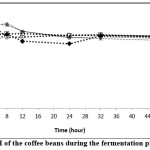 |
Figure 2: pH of the coffee beans during the fermentation process(P<0.) |
The results showed that with in 4 hours of incubation the titratable acidity of all treatments applied tothe Arabica coffee cherries increased from approximately 2.0 to 2.5% (Figure 3). Treatment 4 (T4) generated the highest titratable acidity amongst the other treatments in which within 48 h of incubation it had reached 3% of titratable acidity while others only reached between 2.2 and 2.3% of titratable acidity. This suggested that high proportion of fecal suspension as inoculum added to the coffee cherries may enhance the formation of acids during their fermentation processes. This occurred because the pulps of Arabica coffee cherries were quite rich in carbohydratesand/orpolysaccharides, and there by could be used as substrates and/or source of energy for the growth of microbes.32 Further, during the fermentation, the substrate would be converted into fermentation end-products that may significantly enrich the taste of the fermented coffee beans.6,17
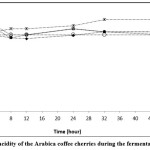 |
Figure 3: Titratable acidity of the Arabica coffee cherries during the fermentation process(P<0.) |
The results showed that the addition of civet fecal suspension as inoculum to the fermentation of Arabica coffee cherries effectively reduced their glucose content. As depicted in Fig. 4, within 4 hours of incubation the sugar concentration of the coffee beans decreased significantly from approximately 17 m M to around 12 m M. The study also revealed that the more inoculum concentration was added the faster glucose was converted. In this study, treatment 4 was able to degrade the sugar of the coffee beans faster than that of the other treatments in which within 24 hours of the incubation approximately 84% of the sugar was converted. Besides, with in 32 hours of incubation T4 had completely degraded sugar in the fermented coffee beans, and within that period the sugar content was lower (0 m M) than that of the coffee beans (0.3 m M) that were in-vivo digested by civet (Table 3).This may be indicated that above 24 hours of incubation the glucose concentration of the fermented coffee beans was completely degraded, and suggested that the use of civet fecal suspension as inoculum would accelerate the sugar conversion.33 This is because during the fermentation sugar content presented in the pulp and mucilage was reduced and consumed by microorganisms while metabolites (i.e. volatile and non-volatile organic acids and alcohols) were formed, thereby would enhance the quality of the coffee including its flavor and aroma.34
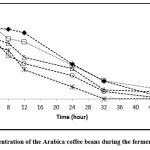 |
Figure 4: Glucose concentration of the Arabica coffee beans during the fermentation process (P<0.) |
The results of the present study showed that the civet fecal suspension used as inoculum effectively reduced the caffeine content of the fermented Arabica coffee beans. As shown in Fig. 5, the higher concentration of the inoculum was added to the fermentation of Arabica coffee cherries the lower concentration of caffeine in the fermented coffee beans was obtained. In this study, treatment 4 containing 40% of the inoculum had the lowest caffeine content (1.8%) of the fermented coffee beans among the other treatments. This is quite different from the control naturally fermenting Arabica coffee cherries that were not using fecal civet suspension as inoculum had higher caffeine content (2.2%).The caffeine content of the tested samples was still higher than that of the original luwak coffee beans digested in-vivo by civet, which were about 1.34% (Table 3). Overall, the fermentation of Arabica coffee cherries using mixed-microbial culture of civet fecal suspension successfully decreased their caffeine content. This result reaffirmed the previous study, which revealed that the use of civet fecal suspension as inoculum had effectively reduced the caffeine content of the fermentable coffee beans.17 They also reported that the use of civet fecal suspension as inoculum could degrade almost 90% of caffeine of the Robusta green coffee beans.
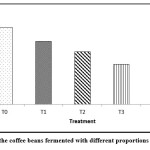 |
Figure 5: Caffeine of the coffee beans fermented with different proportions of inoculum |
Table 3: Physicochemical properties of coffee bean fermented in-vivo by civet(luwak coffee).
| Parameters | Unit | Luwak Coffee Bean |
| Total Solid | % | 48.20 |
| Glucose | mmol/L | 0.28 |
| Caffeine | % | 1.34 |
| pH | – | 4.70 |
The results showed that the moisture content of the fermented coffee beans increased when the concentration of inoculum added was increased (Fig. 6). The moisture content of the coffee beans fermented with civet fecal suspension was higher (63-74%) than that of the control (60%). This occurred since the inoculum used was in the form of liquid. Hence, an increasing proportion of the inoculum would consequently increase the moisture content of the fermented coffee beans. The results of the current study also revealed that the higher the proportion of the inoculum introduced to the fermentation of Arabica coffee cherries the lower the concentration of the total solid of the fermented coffee beans generated. This is because the high concentration of inoculum may be represented as a significant amount of microbes involved in the fermentation processes.35They would enhance the fermentation rates and increase substrate utilization attributed to the decrease of the solid content of the coffee pulp. The substrate was subsequently converted into valuable fermentation end-products that could improve the quality of the fermented coffee beans.36In this study, the total solid of the fermented coffee beans using civet fecal suspension as inoculum were quite lower (26-37 %) in comparison to the original luwak coffee beans in-vivo fermented by civet (48%). This suggested that the use of civet fecal suspension as inoculum would effectively degrade the solid content of the coffee pulp.
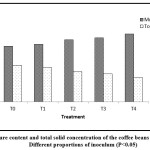 |
Figure 6: Moisture content and total solid concentration of the coffee beans fermented with different proportions of inoculum (P<0.05) |
Conclusion
The quality of Arabica coffee beans had been improved through the fermentation processes using civet fecal suspensions. The fermentation of Arabica coffee cherries using mixed microbial culture of civet fecal suspension successfully reduced their glucose content. Within above 24 hours of the fermentation process, the addition of 40% inoculum to the Arabica coffee cherries was able to convert the sugar content of the coffee beans. The use of mixed microbial culture of civet fecal suspension for the fermentation of Arabica coffee cherries significantly reduced their caffeine content from 2.20% to 1.84%. This is substantially significant since the fermentation of Arabica coffee cherries using civet fecal suspension could enhance the quality of the coffee beans by reducing caffeine and sugar content.
Acknowledgments
The authors acknowledge the Directorate of Research and Community Service, the Ministry of Education, Culture, Research and Technology, Indonesia
Conflict of Interests
The authors stated that they have no conflict of interest to publish the article.
Funding Sources
This research is funded by the scheme of the National Competitive Basic Research PDKN (grant number: 39/UN11.2.1/PT.01.03/DRPM/2022).
References
- E.T., Melchor-Martínez E.M., Sierra J.S.O., Ramirez-Mendoza R.A., Parra-Saldívar R., Iqbal H. M. N. Impact of Climate Change and Early Development of Coffee Rust–An Overview of Control Strategies to Preserve Organic Cultivars in Mexico. Sci Total Environ. 2020;738: 140225.doi:10.1016/j.scitotenv.2020.140225.
CrossRef - Huch M., Franz C.M.A.P. Coffee: Fermentation and Microbiota. In Advances in Fermented Foods and Beverages. Holzapfel W. (Editor). Swaston, UK. Woodhead Publishing. 2015; 21: 501-513.doi:1016/B978-1-78242-015-6.00021-9
CrossRef - Hall R.D.,Trevisan F., de Vos R.C. H. Coffee Berry and Green Bean Chemistry–Opportunities for Improving Cup Quality and Crop Circularity. Food Res Int. 2022;151: 110825.doi:1016/j.foodres.2021.110825
CrossRef - Haile M., Kang W.H. The Role of Microbes in Coffee Fermentation and Their Impact on Coffee Quality. J Food Qual.2019.doi:1155/2019/4836709.
CrossRef - Ameca G. M., Cerrilla M. E. O., Córdoba P. Z., Cruz A. D., Hernández M. S., Haro J. H. Chemical Composition and Antioxidant Capacity of Coffee Pulp. CiêncAgrotec. 2018;42(3):307-313.doi:1590/1413-70542018423000818.
CrossRef - Klingel T., Kremer J. I., Gottstein V.,Rajcic de Rezende T., Schwarz S.,Lachenmeier D.W. A Review of Coffee By-Products Including Leaf, Flower, Cherry, Husk, Silver Skin, and Spent Grounds AsNovel Foods within The European Union. Foods. 2020;9: 665. doi:3390/foods9050665.
CrossRef - Haile M., Kang W.H. Isolation, Identification, and Characterization of Pectinolytic Yeasts for Starter Culture in Coffee Fermentation. Microorganisms. 2019;7: 401.doi:3390/microorganisms7100401.
CrossRef - Lee L.W., Cheong M.W., Curran P., Yu B., Liu S.Q. Coffee Fermentation and Flavor–An Intricate and Delicate Relationship. Food Chem. 2015;185: 182-191.doi:1016/j.foodchem.2015.03.124
CrossRef - Silva C.F.,Vilela D.M., de Souza Cordeiro C., Duarte W.F., Dias D.R., Schwan R.F. Evaluation of APotential Starter Culture for Enhance Quality of Coffee Fermentation. World J MicrobiolBiotechnol. 2013;29: 235-247.doi: 10.1007/s11274-012-1175-2.
CrossRef - Elhalis H., Cox J., Frank D., Zhao J. Microbiological and Biochemical Performances of Six Yeast Species AsPotential Starter Cultures for Wet Fermentation of Coffee Beans.LWT-Food Sci Technol. 2021;137: 110430.doi:1016/j.lwt.2020.110430.
CrossRef - De Maria C.A.B.,Trugo L.C.,Neto F.A., Moreira R.F.A.,Alviano C.S. Composition of Green Coffee Water-Soluble Fractions and Identification of Volatiles Formed During Roasting. Food Chem. 1996;55: 203-207.doi:1016/0308-8146(95)00104-2.
CrossRef - B., de Melo Pereira G.V., da Silva Vale A., de Carvalho Neto D. P.,Soccol C.R. Influence of Environmental Microbiota on the Activity and Metabolism of Starter Cultures Used in Coffee Beans Fermentation. Fermentation. 2021;7: 278.doi:10.3390/fermentation7040278.
CrossRef - De Bruyn F., Zhang S.J.,Pothakos V., Torres J.,Lambot C., Moroni A.V., De Vuyst L. Exploring TheImpacts of Postharvest Processing on The Microbiota and Metabolite Profiles During Green Coffee Bean Production. ApplEnvironlMicrobiol. 2017;83: e02398-16.doi:1128/AEM.02398-16.
CrossRef - De Carvalho Neto D.P.,Vinícius De Melo Pereira G.,Finco A.M.O., Rodrigues C., Carvalho J.C.D.,Soccol C.R. Microbiological, Physicochemical and Sensory Studies of Coffee Beans Fermentation Conducted in AYeast BioreactorModel. Food Biotechnol. 2020;34: 172-192.doi:1080/08905436.2020.1746666.
CrossRef - Wang C., Sun J.,Lassabliere B., Yu B., ZhaoF., Zhao F., Liu S. Q. Potential of Lactic Acid Bacteria to Modulate Coffee Volatiles and Effect of Glucose Supplementation: Fermentation of Green Coffee Beans and Impact of Coffee Roasting. JSciFood Agric. 2019; 99: 409-420.doi:1002/jsfa.9202.
CrossRef - Liu Y., Yuan W., Lu Y., Liu S.Q. Biotransformation of Spent Coffee Grounds by Fermentation with Monocultures of Saccharomyces cerevisiae and LachanceathermotoleransAided by Yeast Extracts. LWT. 2021;138: 110751.doi:1016/j.lwt.2020.110751.
CrossRef - Darwin, Mahyudi R.,Sundari D.,Muliawati A. Influence of Solid State Fermentation on Robusta Coffee (Coffeacanephora) Beans Inoculated with Microbial Culture of Civet Fecal Suspensions. Res Crops. 2021;22(4): 968-976.doi: 10.31830/2348-7542.2021.158.
CrossRef - Watanabe H., Ng C.H., Limviphuvadh V., Suzuki S., Yamada T. GluconobacterDominatesThe Gut Microbiome of The Asian Palm Civet Paradoxurus hermaphroditus that Produces Kopi Luwak. Peer J. 2020; 8: e9579. doi:7717/peerj.9579.
CrossRef - Baird R.B., Eaton A.D.,Clesceri L.S. Standard Methods for The Examination of Water and Wastewater (Vol. 10). E. W. Rice (Ed.). American Public Health Association. 2012.Washington DC, USA.
- Darwin, Ilham M.,Fazil A. Performance and Kinetic Study of The Anaerobic Co-Digestion of Cocoa Husk and Digested Cow Manure with High Organic Loading Rate. INMATEH-Agric Eng. 2018;55: 131-140.
- Darwin, Purwanto S., Rinaldi R. Removal of Organic Pollutants from Tofu-Processing Wastewater through Anaerobic Treatment Process with Short Hydraulic Retention Time. Environ ResEngManag. 2019;75: 34-42.doi:5755/j01.erem.75.1.21532.
CrossRef - Gautz L. D., Smith V. E.,Bittenbender H. C. Measuring Coffee Bean Moisture Content. In Cooperative Extension Services, College of Tropical Agriculture and Human Resources. 1-3 pp. University of Hawai’i at Manoa, 2008; EN-3.
CrossRef - Darwin,Triovanta U., Rinaldi R.,Pratama A. Anaerobic Acidification of Coconut Water Waste by Lactobacillus acidophilusCulture for Biotechnological Production of Lactic Acid. Acta UnivAgricSilvicMendelBrun. 2019;67: 1433-14440.doi: 10.11118/actaun201967061433.
CrossRef - Determination of Glucose Concentration in Anaerobic Acidification Cultures by Portable Glucose Monitoring System.Asian J Chem. 2019; 31: 763-766.doi:10.14233/ajchem.2019.21593.
CrossRef - Weldegebreal B., Redi-Abshiro M.,Chandravanshi B.S. Development of New Analytical Methods for The Determination of Caffeine Content in Aqueous Solution of Green Coffee Beans. Chem Cent J. 2017;11: 1-9.doi: 10.1186/s13065-017-0356-3.
CrossRef - Robertson A.H., Fisher H.J., Horwitz W. Official Method of Analysis of The Association of Official Agricultural Chemist Literary Licensing, LLC, USA. 2012.
- Darwin, Cord-Ruwisch R. Thermodynamics of Anaerobic Digestion: Mechanism of Suppression on Biogas Production During Acidogenesis. INMATEH-Agric Eng. 2019;57(1): 287-301.
- Yu P., Tu W., Wu M., Zhang Z., Wang H. Pilot-Scale Fermentation of Urban Food Waste for Volatile Fatty Acids Production: The importance of pH. Bioresour Technol. 2021;332: 125116.doi:1016/j.biortech.2021.125116.
CrossRef - Darwin, Charles W., Cord-Ruwisch R. Anaerobic Acidification of Sugar-Containing Wastewater for Biotechnological Production of Organic Acids and Ethanol. Environ Technol. 2019; 40: 3276–3286. doi:1080/09593330.2018.1468489.
CrossRef - Elhalis H., Cox J., Zhao J. Ecological Diversity, Evolution and Metabolism of Microbial Communities in The Wet Fermentation of Australian Coffee Beans. IntJFood Microbiol. 2020;321: 108544.doi:1016/j.ijfoodmicro.2020.108544.
CrossRef - Reale A.,Zotta T.,Ianniello R.G.,Mamone G., Di Renzo T. Selection Criteria of Lactic Acid Bacteria to be Used AsStarter for Sweet and Salty Leavened Baked Products. LWT. 2020;133, 110092.doi:1016/j.lwt.2020.110092.
CrossRef - Frómeta R.A.R., Sánchez J.L., García J.M.R. Evaluation of Coffee Pulp AsSubstrate for PolygalacturonaseProduction in Solid State Fermentation. Emir J Food Agric. 2020; 32: 117-124.doi:9755/ejfa.2020.v32.i2.2068.
CrossRef - Argun H., Dao S. Bio-Hydrogen Production from Waste Peach Pulp by Dark Fermentation: Effect of Inoculum Addition. Int JHydrog Energy. 2017;42(4): 2569-2574.doi:1016/j.ijhydene.2016.06.225.
CrossRef - Lee L.W., Cheong M.W., Curran P., Yu B., Liu S.Q. Coffee Fermentation and Flavor–An Intricate and Delicate Relationship. Food Chem.2015;185:182-191. doi:10.1016/j.foodchem.2015.03.124.
CrossRef - Sandhya M.V.S.,Yallappa B.S.,Varadaraj M.C.,Puranaik J., Rao L.J., Janardhan P., Murthy P.S. Inoculum of The Starter Consortia and Interactive Metabolic Process in Enhancing Quality of Cocoa Bean (Theobroma cacao) Fermentation. LWT-Food Sci Technol. 2016;65: 731-738.doi:1016/j.lwt.2015.09.002.
CrossRef - da Mota M.C.B., Batista N.N.,Rabelo M.H.S., Ribeiro D.E.,Borém F.M., Schwan R.F. Influence of Fermentation Conditions on The Sensorial Quality of Coffee Inoculated with Yeast. Food Res Int. 2020; 136: 109482.doi:10.1016/j.foodres.2020.109482.
CrossRef

This work is licensed under a Creative Commons Attribution 4.0 International License.






